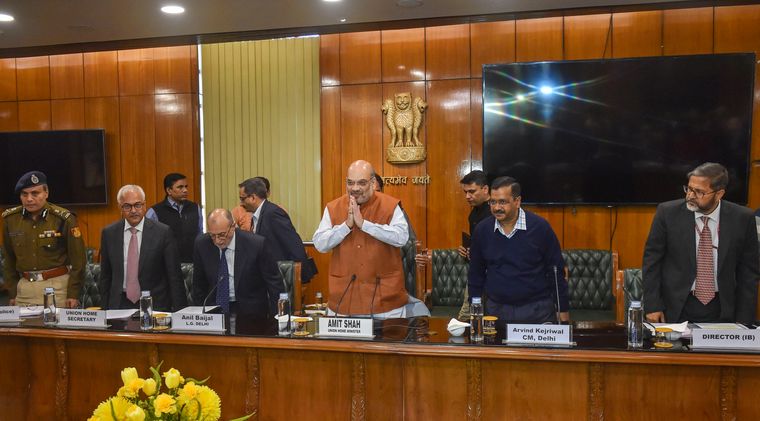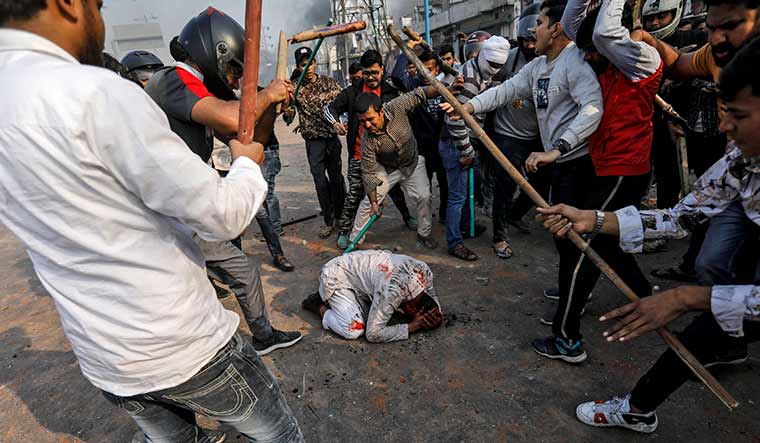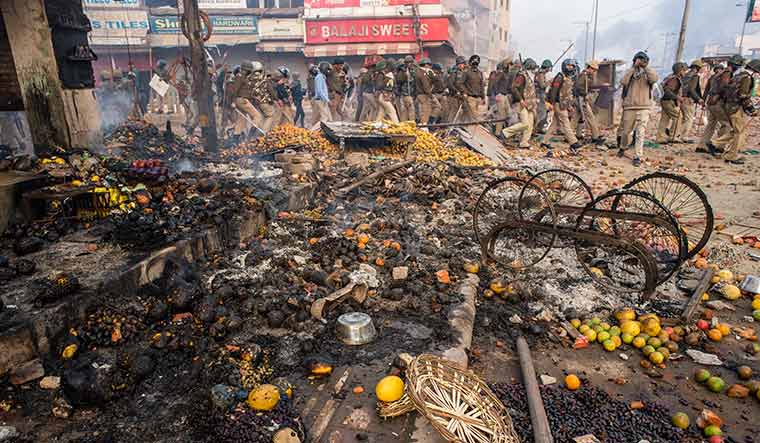By 7:30pm on February 25, more than 72 hours after a group of women had blocked the road outside the Jaffrabad metro station to replicate the protest against the Citizenship (Amendment) Act at Shaheen Bagh, authorities used a time-tested technique to tackle the agitators—a nudge and a push. Hours earlier, community elders had visited the spot and local mosques had appealed to the protesters to disperse, saying that their names were being used to incite violence in the city and discredit the movement. Finally, the police swooped in, asking the protesters to clear the area or move to nearby Seelampur, where a similar sit-in by women had been on for a month, but which had not blocked the key arterial road.
Unfortunately, the textbook technique was used too late. For the past three days, the densely populated North East Delhi, which shares its border with Ghaziabad in Uttar Pradesh, had been on fire. Groups of young, armed men had clashed, killing and maiming, setting religious places on fire and burning shops. What started as a flareup between the pro- and anti-CAA camps had turned into communal riots. At least 27 people lost their lives, including two security personnel, in the worst episode of violence in the capital since the 1984 anti-Sikh riots. The Delhi Police, which had failed to prevent the riots then, were found wanting again. They were outnumbered and were, at their worst, mute spectators.
All this happened as India was hosting US President Donald Trump, who, on his maiden official visit, was taken to two places closely associated with Mahatma Gandhi—Sabarmati Ashram and Rajghat. By the time Trump left, Gandhi’s enduring message of non-violence lay in tatters.
The violence erupted on February 23, after CAA supporters gathered near the Jaffrabad station, with the anti-CAA people on other side. BJP leader Kapil Mishra had given an ultimatum, telling protesters to vacate the road or face action after Trump’s visit was over.
It started with stone pelting, which soon spread to neighbouring areas, but the police managed to “control” it. By the time Trump had reached Agra to see the Taj Mahal, the clashes had become riots. There were reports of violence from the adjacent areas of Karawal Nagar, Chand Bagh, Maujpur and Babarpur.
“It appears to be a deliberate attempt to create communal unrest by some organisations and individuals,” Minister of State for Home G. Kishan Reddy told THE WEEK. “Why did the violence happen during President Trump’s visit? Different inputs are coming from everywhere and the Delhi Police are looking into all these.”
Home Minister Amit Shah monitored the law-and-order situation over the course of several meetings. The government then decided to go for strong police action at the end of Trump’s two-day visit. Around 40 companies of paramilitary forces were rushed in, Section 144 of the CrPC was imposed, and shoot-at-sight orders were given on February 25 at 6:30pm, half an hour after Shah appointed 1985-batch IPS officer S.N. Shrivastava as special commissioner of police (law and order). (In the interview with THE WEEK [page 48], Kishan Reddy denied shoot-at-sight orders being given). Finally, National Security Adviser Ajit Doval stepped in and visited the affected areas to “instil a sense of normalcy”.
But not before the damage was done. “I was sitting on the Jaffrabad road (on February 25),” Shamina, a protester, told THE WEEK. “When the maulvi asked us to clear the road, many of us moved, but some insisted that we should not leave the place as our cause was important. As the disagreement continued, I thought it was better to leave.” When the police came in full strength and gear, the men were the first to flee, she added.
As a crowd of agitated onlookers from Janata Colony, opposite the Jaffrabad metro station, watched the action, the police charged at them, hitting everyone that came their way, and fired tear gas shells. The pungent gas dispelled the crowd.
The elderly among the crowd asked the youngsters not to throw stones or retaliate. “Enough damage has been done,” Razak, who was at Janata Colony, told THE WEEK. “We have been living in fear. There have been rumours that we may be attacked. Our businesses have suffered. The violence started after Kapil Mishra gave out that warning.”
Mishra’s name came up a lot as the riots rocked North East Delhi, which is known for its Muslim ghettos. While Shaheen Bagh, in upscale South Delhi, had become a symbol of resistance, with liberals, academics, musicians, activists and journalists making regular visits and putting it on the national map, the protests in Seelampur, near North East Delhi, had gone unnoticed. The riot-affected areas fall on the other side of the Yamuna, with lower middle class Muslims and migrants forming the majority of the population. The area has been prone to communal flareups, as had happened in Trilokpuri in November 2014. In the recent assembly elections, the majority of the Muslim votes went to the AAP, while most of the Hindus voted for the BJP, which had made Shaheen Bagh a leitmotif of its campaign.
But unlike in Shaheen Bagh, where the protesters have been restrained under provocation, the anti-CAA protesters in the northeast responded with ferocity to far-right crowds that had gathered to oppose them. As both sides had been equally polarised, it did not matter who cast the first stone.
What did matter were the major slippages at several levels. The political leadership left a lot to be desired; it was slow in engaging with the residents who needed assurance and help. Delhi Chief Minister Arvind Kejriwal was muted in his response to the violence. He termed it a law-and-order issue and seemed to pass the buck to the Centre. And although several Muslim groups had called on his residence on the night of February 26, asking for his intervention, he visited the riot-affected areas only after the High Court asked him to.
All the while, on ground, the brutality was shocking. As these were the first large-scale riots to take place in the smartphone era, every passing minute threw up gruesome photos and videos on social media. While the picture of Mohammad Zubair—hunched on his knees, getting beaten by armed men—evoked disgust, the brazenness with which Mohammed Shahrukh brandished a gun at policemen triggered outrage. Head Constable Ratan Lal, with his moustache shaped like that of Air Force pilot Abhinandan Varthaman, became the first policeman to be killed in the violence. He was declared a martyr as he died on duty. Then, on February 25, Intelligence Bureau officer Ankit Sharma’s body was found in a drain near his home in Chand Bagh.
Doctors at the state-run Guru Teg Bahadur Hospital said that at least 30 per cent of the injuries and fatalities were due to gunshots. “My son, Ravi, was returning from temple when he was shot twice in the neck and the chest,” Suresh Chander Halwai, a resident of Durgapuri, told THE WEEK as he waited in the emergency area of GTB hospital. “The riots were happening nearby, but he was not part of it. He was innocent. We do not know who shot him. He celebrated his 19th birthday yesterday.”
Ravi was not the only one dragged into the violence. Rahul Thakur, 22, was standing outside his house in Brijpuri, along with his two friends, when he was hit by a bullet. “He was not part of the protest,” his cousin Amit told THE WEEK. “He was guarding his house. He was hit in his chest, while his friends escaped. He had just cleared his SSC competitive exam, and was preparing for the next phase.” Rahul’s father is a Railway Protection Force head constable posted in Haryana. “People should see what is happening,” added Amit. “They just raise issues for their convenience. They sit in studios for five minutes and rant. It is people like us who become victims.”
Arshad, a 23-year-old correspondence student from Maujpur, told THE WEEK: “It is our age to hold books, not guns. Look what is happening.” He pointed to a bullet lodged in his right leg as he lay on a stretcher. “I, along with other people of my community, was standing guard at our mosque, thinking that it would not be attacked. Then some people started pelting stones. I tried telling them to refrain as it would only escalate the matter. I had good relations with the local policemen, so I tried telling our people that they were here to protect us. But the police came charging in. They shot me in the leg. I never expected this.”
Similar tales of grief now unite the members of two communities who have fallen victim to inflamed passions.
In the evening of February 25, Union Health Minister Harsh Vardhan visited GTB hospital, where a majority of the injured were admitted, along with Delhi BJP president Manoj Tiwari. “I pray to everyone that they not trust rumours, and maintain harmonious relations in society. People should act with patience and bring back peace,” said the minister. On being asked whom he held responsible for the situation, he said he did not want to add anything more.
Also read
- Furore after men seen scaling walls of Delhi Miranda House during campus Diwali fest
- Opposition seeks President's intervention in Delhi Police probe into February riots
- Conspiracy involving Tahir Hussain, Umar Khalid: What Delhi riots chargesheets claim
- Ex-AAP councillor Tahir Hussain, accused in the Delhi violence, surrenders
- Shahrukh who opened fire during Delhi violence arrested from Bareilly
It was the Delhi High Court that took cognisance of Kapil Mishra’s speech. The court wanted the Delhi Police to register cases against him and two other BJP leaders—Anurag Thakur and Parvesh Verma—for making provocative statements during the Delhi elections, which could have been a precursor to the violence. Mishra, however, remained defiant, saying he did no wrong and had only asked for the Jaffrabad road to be opened. Many BJP leaders had hailed him for daring to stand up against the “illegal” act of shutting down a road.
Many in the BJP have also pointed to equally provocative statements from those opposing the CAA, including a provocative speech by All India Majlis-e-Ittehadul Muslimeen leader Waris Pathan.
On February 26, after three days of mayhem, an uneasy calm returned to North East Delhi. But the social fabric of the city, which the worst riots in three decades have ripped apart, will take a long time to heal. Doval’s intervention appeared to have eased tensions, and his arrival indicated that Prime Minister Narendra Modi was directly monitoring the situation and wanted it resolved immediately.
For instance, on February 26, the High Court had to intervene as the police were not able to provide security to ambulances that were rescuing the injured who were stuck at various places. Sources said that while the police had inputs that the situation could take a violent turn, they were not as proactive as expected.
Delhi Police Commissioner Amulya Patnaik is said to be a man of few words. But his tenure has been marked with sparser action. The police’s strong action at Jamia Millia Islamia—when it entered the campus to beat up students—proved to be a turning point in the entire anti-CAA movement. After that, when armed gangs attacked students at the Jawaharlal Nehru University, the police failed to arrest anyone. The force appeared to lack leadership; at one point, in November, its personnel had to hold protests as some policemen were attacked by lawyers.
On February 26, Patnaik said senior officers were doing the rounds and normalcy had returned. “We are also associating in peace committee meetings,” he said. “The incidents had taken place in the interior lanes of the city. We responded to calls.”
Delhi Police spokesman M.S. Randhawa said the police had registered 18 FIRs and had arrested more than 100 people, and added that they were identifying miscreants through CCTV cameras and other evidence.
Former home secretary G.K. Pillai told THE WEEK: “It showed lack of leadership in the Delhi Police. It brought lapses in the way policing is being done in the capital. Riots cannot be allowed to continue like this. It is time for introspection as things have gone wrong.”
Former Delhi Police commissioner Ajai Raj Sharma, known for his effective policing, said, “Even the Shaheen Bagh sit-in should not have been allowed in the first place. Once it continued, it generated communal feelings, which escalated during state elections. This communal situation has culminated in these riots.”
Sharma listed three lapses. “The police should have rounded up anti-social elements, especially those who could be in possession of illegal guns, as it would have defused the situation. The second lapse happened as Section 144 was put in much later, and once it was imposed, the police should have had enough force. People cannot be allowed to gather after Section 144, otherwise the effects are adverse. And the third lapse was the delay in imposing curfew.”
He said law and order should be put on the concurrent list, with both the Centre and the states having an equal role to play. “The police needs to be insulated from politics.”
With Namrata Biji Ahuja





